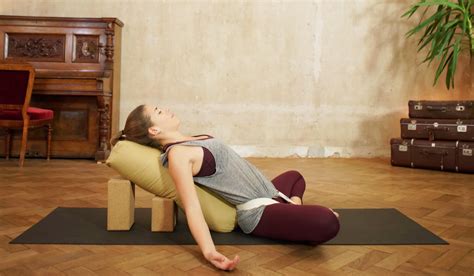Exploring the Benefits and Drawbacks of Restorative Yoga: Is It the Right Practice for You?
Restorative yoga has surged in popularity, especially among those seeking a practice that focuses on relaxation, healing, and balance. Unlike more vigorous forms of yoga, restorative yoga emphasizes stillness, long-held poses, and deep breathing. But how do you know if this calming practice is right for you? To answer this question, we must explore restorative yoga from multiple angles, taking into account its benefits, potential drawbacks, and practical applications in modern life.
Introduction
Restorative yoga is a gentle form of yoga designed to encourage physical, mental, and emotional relaxation. The practice involves holding passive poses for extended periods, often using props like blankets and bolsters to support the body. While some praise restorative yoga for its calming benefits, others question its effectiveness for those seeking more physically demanding exercise or faster results. In this article, we’ll dive deep into restorative yoga, examining the key concepts, historical background, modern applications, and expert opinions on whether this form of yoga is right for you.
Key Concepts of Restorative Yoga
- Relaxation: The primary goal is deep relaxation through long-held, supported postures.
- Minimal movement: Unlike vinyasa or ashtanga yoga, there is very little movement, with an emphasis on stillness.
- Use of props: Props are key to providing the necessary support to hold poses comfortably.
- Focus on breath: Slow, deep breathing is integral to the practice, aiding in relaxation.
- Mindfulness: Restorative yoga encourages practitioners to cultivate mindfulness by being present in each pose.
Historical Context of Restorative Yoga
Restorative yoga traces its roots to B.K.S. Iyengar’s teachings in the 20th century. Iyengar, a prominent yoga teacher, introduced the use of props to help practitioners achieve the correct alignment and fully experience each pose. His emphasis on holding poses for longer durations formed the foundation of what we now call restorative yoga. While restorative yoga evolved as a branch of Iyengar yoga, it has since become a popular practice in its own right, often viewed as a counterbalance to the fast-paced lifestyle of the modern world.
Current State Analysis
Today, restorative yoga is practiced in studios, gyms, and even at home via online platforms. The practice is often marketed as a way to reduce stress, improve mental health, and promote physical healing. However, there are mixed views on its overall effectiveness. Some argue that the gentle nature of restorative yoga may not be challenging enough for those seeking physical fitness or strength building. Others believe it serves a vital role in helping people manage chronic pain, insomnia, or high stress.
Pros of Restorative Yoga:
- Promotes deep relaxation and stress relief.
- Can be practiced by people of all fitness levels, including beginners.
- Uses props to ensure comfort and correct alignment.
- May improve sleep quality and reduce symptoms of anxiety and depression.
Cons of Restorative Yoga:
- May not provide enough physical challenge for some.
- Results may take longer to achieve compared to more intense forms of exercise.
- Requires patience and commitment to experience full benefits.
Practical Applications
Restorative yoga has numerous applications in everyday life, particularly for individuals dealing with stress, chronic pain, or mental health challenges. Here are a few ways it can be incorporated into a wellness routine:
- Stress management: Practicing restorative yoga for 20–30 minutes a day can help lower cortisol levels and promote relaxation.
- Chronic pain relief: The gentle, supported poses can alleviate tension in muscles and joints, making it suitable for those with arthritis or back pain.
- Mindfulness training: The emphasis on breathing and stillness makes it a valuable tool for practicing mindfulness and meditation.
- Post-injury rehabilitation: Restorative yoga can be used as part of a recovery program, allowing individuals to maintain flexibility without overexertion.
Case Studies
| Case Study | Condition | Outcome |
|---|---|---|
| Study 1: Managing Anxiety with Restorative Yoga | Anxiety disorder | Participants reported a 40% reduction in anxiety symptoms after 8 weeks of practice. |
| Study 2: Using Restorative Yoga for Chronic Pain | Chronic lower back pain | After 12 weeks, participants experienced a significant decrease in pain levels and improved mobility. |
| Study 3: Impact of Restorative Yoga on Sleep | Insomnia | 80% of participants reported improved sleep quality after incorporating restorative yoga into their nighttime routine. |
Stakeholder Analysis
Restorative yoga appeals to a wide range of stakeholders, from individual practitioners to healthcare providers and wellness companies. Here’s a breakdown of key groups that benefit from or engage with restorative yoga:
- Individual Practitioners: People seeking stress relief, pain management, or mindfulness training.
- Yoga Instructors: Teachers who want to offer a gentler, more inclusive form of yoga to their students.
- Healthcare Providers: Physical therapists and mental health professionals integrating yoga into their treatment plans.
- Wellness Companies: Businesses that cater to relaxation, mindfulness, or holistic health markets.
Implementation Guidelines
Implementing restorative yoga into a wellness program requires careful planning and consideration of the needs of the participants. Below are some guidelines for effective implementation:
- Create a supportive environment: Ensure that props are available and that the space is conducive to relaxation, such as low lighting and minimal noise.
- Start slow: For beginners, start with simple poses held for 5–10 minutes, gradually increasing the duration over time.
- Encourage consistency: To see the full benefits, practitioners should aim for regular practice, ideally several times a week.
- Focus on breath: Always emphasize slow, deep breathing as a cornerstone of the practice.
Ethical Considerations
While restorative yoga is generally regarded as a safe and beneficial practice, there are ethical considerations to take into account. Practitioners should ensure they are not making exaggerated claims about the benefits of restorative yoga, particularly when working with vulnerable populations, such as those with mental health issues or chronic illness. It’s important to emphasize that while restorative yoga can support overall well-being, it should not be considered a substitute for medical treatment when necessary.
Limitations and Future Research
Restorative yoga has limitations, especially when it comes to providing a comprehensive physical workout. Those seeking cardiovascular fitness or strength training may need to supplement their practice with other forms of exercise. Additionally, while the mental health benefits are widely reported, more scientific research is needed to establish the long-term effects of restorative yoga on anxiety, depression, and sleep disorders.
Future research should also examine how restorative yoga can be tailored for specific populations, such as older adults, individuals with disabilities, or those recovering from trauma. More case studies and clinical trials will help provide a clearer understanding of how restorative yoga can be optimized for diverse groups of people.
Expert Commentary
According to leading experts in the field of yoga therapy, restorative yoga offers a unique balance of relaxation and mindfulness that is particularly well-suited for today’s fast-paced, stress-laden world. Dr. Elena Brower, a renowned yoga teacher and mindfulness expert, suggests that “restorative yoga is not just a practice; it’s a mindset that helps you cultivate patience, acceptance, and inner peace.”
However, some professionals emphasize that the benefits of restorative yoga may not be fully realized unless it is practiced consistently and with intention. “This isn’t a quick fix,” notes physical therapist David Emerson. “It’s a long-term approach to health, and its effectiveness depends on commitment.”
In the end, restorative yoga may not be the right choice for everyone, but for those seeking a slower, more mindful approach to well-being, it offers invaluable tools for relaxation, recovery, and personal growth.








